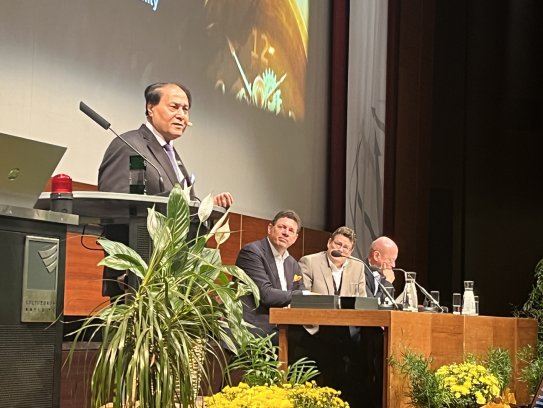
Instant detection with Fabritell
Opinion


Shape-shifting industry responding to many pressures, including a “tsunami” of new legislation in Europe.

15th September 2024
Adrian Wilson
|
Dornbirn, Austria
Despite the somewhat depressed economic market for much of the textile supply chain at present, there were plenty of reasons for optimism at the Dornbirn Global Fibers Congress (GFC) which was held from September 11-13 in the Austrian town.
There was a clear sense of momentum being gained in a number of key fields which, in combination, will significantly and very positively reshape the industry in the next few years.
Firstly, advanced technologies for the sorting and recycling of post-consumer waste textiles are rapidly advancing in response to upcoming legislation, initially within the European Union.
Alongside this, many alternative new fibres and raw materials are arising, not only as viable alternatives to oil-based synthetics, but also to resource-hungry cotton.
In a third encouraging development, the market for second-hand apparel is currently going through the roof.
Pressures
It fell to Frederic van Houte, director of CIRFS, the European manmade fibres association, to deliver the initial bad news.
The European fibres industry, despite its flexibility and R&D strength, is suffering from a slow economy and negative growth, he said, with weak demand and high costs, especially for energy and raw materials.
Europe’s industry faces increasing pressure from subsidised production in Asia and protective tariffs are increasingly being imposed, he added, while massive over-capacity is leading to dumping and free trade agreements very often have political dimensions that are detrimental to EU trade. On top of this, the rise of the ultra-fast digital fashion brands has been associated with the loss of 10,000 retail jobs in Europe and is resulting in a flood of products that are often not being made to quality expectations.
“European manufacturers now face a tsunami of new laws and everything must be done to ensure a level playing field,” van Houte concluded. “We must make sure that legislation remains manageable.”
Brand action
Providing a more upbeat message while acknowledging the depressed market, Giuseppe Gherzi of the Swiss consultancy Gherzi, provided a list of some 34 trends that are currently having an impact, categorised under the seven broad fields of Resources, Design, Production, Retail, Consumption, Systems Thinking and Regulation and End of Life.
He observed that brands are now no longer just sourcing materials, but taking a much more active role in their supply chains, with positive benefits.
In addition, strong new companies are entering the market with good financing and access to the brands. Here, Gherzi cited the example of Brazilian company Galy, a developer of lab-grown cotton, which has just secured funding of some $33 million to accelerate its development.
He also reported findings from ThredUp’s recent 2024 Resale Report which show that the global second-hand apparel market had a value of $200 billion in 2023 and will grow to $350 billion by 2028. The US second-hand apparel market alone grew seven times faster than the broader retail clothing market in 2023 and is expected to reach $73 billion by 2028. By the end of 2023, 163 brands were offering resale shops – a 31% increase on 2022.
As such, the second-hand market is poised to soon eclipse both the $130 billion market for fast fashion and the $50 billion market for ultra-fast fashion. By 2028, it will represent approaching 10% of the overall $2+ trillion apparel market.
Recycling and new fibres
On the recycling front, the full automation of processes continues, and positive progress was reported by key technology providers including Andritz, Tomra and Valvan, all of whom announced strong orders and expansion plans. In addition, 23 pioneering companies presented new fibre solutions at the 4th Innovation Days conference which ran alongside the established Dornbirn sessions.
With 125 lectures taking place across four parallel sessions over just two-and-a-half days, the 500+ delegates at this year’s conference doubtless came away with very separate impressions of the current state of the industry, but there is little doubt that positive change is underway.
The next Dornbirn-GFC will take place from September 10-12 2025, followed by the next Asian GFC, to be held in partnership with TechTextil India and Messe Frankfurt in Mumbai, India, in November 2025.

Business intelligence for the fibre, textiles and apparel industries: technologies, innovations, markets, investments, trade policy, sourcing, strategy...
Find out more